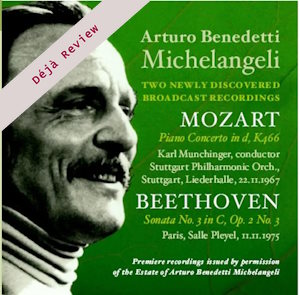
Déjà Review: this review was first published in March 2005 and the recording is still available.
Wolfgang Amadeus Mozart (1756-91)
Piano Concerto No. 20 in D minor, K466 (1785)
Ludwig van Beethoven (1770-1827)
Piano Sonata No. 3 in C, Op. 2 No. 3 (1795)
Arturo Benedetti Michelangeli (piano)
Stuttgart Philharmonic Orchestra/Karl Münchinger
rec. (broadcasts), 22 November 1967, Liederhalle, Stuttgart (Mozart); 11 November 1975, Salle Pleyel, Paris (Beethoven). ADD
Music & Arts CD-1147 [59]
‘Premiere recordings issued by the Estate of Arturo Benedetti Michelangeli’, proudly proclaims the front cover. On the other hand the booklet essay, by Jed Distler, is taken from an article in Gramophone of April 2003 and is not concerned with these particular performances, dwelling instead on the legend that is Michelangeli, to this day. The more we have of this elusive genius the better, so even before any discussion of the performances themselves we have an invaluable document.
After seeing the Michelangeli Lugano recital on DVD, it is difficult not to imagine him as he plays, his face almost mask-like. Interesting how he raises the level of the Mozart from its rather workaday orchestral exposition through an almost regal rendering of the solo part all the way to a sovereign, multi-coloured cadenza. Michelangeli does generate a perhaps surprising amount of adrenalin, though. Try the split bass octaves at 3’20 in, for example.
The infamous literalism kicks in in the Romanze. Whatever its patrician bearing, it remains difficult to imagine anyone being actually seduced by this! There is even a finger-slip at around 4’35, just in case anyone thinks Michelangeli superhuman. The middle section holds considerable drama and, such is the interaction between piano and orchestra, one begins to see Münchinger, occasionally heavy-handed in the first movement, in a different light.
No doubting the minor mode of the explosive finale. The ‘provincial’ orchestra simply cannot match Michelangeli’s vim and verve here, leading again to the elevation of the stature of the exploratory cadenza. The end is perhaps not supremely high voltage – again perhaps resulting from the mismatch of pianist and orchestra.
A fascinating document, and an invaluable addition to the five other Mozart 20s available from this pianist from various labels.
Michelangeli is blissfully alone in the Beethoven Sonata. Why Michelangeli chose the select few sonatas he did must presumably remain buried with him, but he makes a more than solid case for this one … and, perhaps predictable, plays fewer wrong notes than most – although there are some. Accents are harsh at times, almost violent, but this is in keeping with the grand scale on which he paints. He ends the exposition as if it is the end of the movement, such is his finality. His tone is uncompromising. There is a simply massive chord at 9’18, while the chords right at the end are awe-inspiring!
The Adagio is more emotive than one might expect from this particular set of fingers, the organ-like bass at around two minutes in totally in keeping with his conception. The sprightly yet robust Scherzo leads to a mightily impressive, in finger-work terms, finale, although some might find accents periodically stabbed-at.
A must-hear for Michelangeli fans, and indeed for all lovers of great pianism. Which is what this is, when all is considered.
Colin Clarke
Help us financially by purchasing from



















